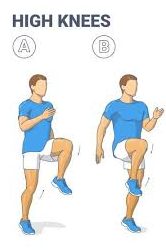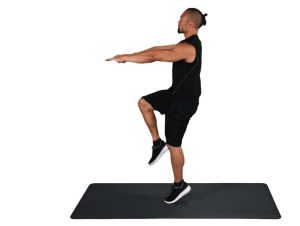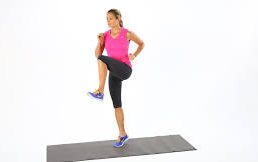How To Do High Knees: Benefits, Muscles Worked Variations

Welcome to our How To Do High Knees: Benefits, Muscles Worked Variations comprehensive guide on how to do high knees! This dynamic exercise is a fantastic addition to any workout routine, as it engages multiple muscle groups and offers numerous benefits. In this article, we will walk you through the proper form and technique for performing high knees, discuss the muscles worked during this exercise, and explore some exciting variations to keep your workouts fresh and challenging. Let’s get started!
Benefits of High Knees
High knees are not only a fun and energizing exercise but also bring a wide range of benefits to the table. By incorporating high knees into your fitness regimen, you can enjoy the following advantages: hamstrings, hip flexors, and core muscles.
Cardiovascular Conditioning:
High knees are an excellent cardiovascular exercise that helps elevate your heart rate, improving your overall cardiovascular health and endurance.
Sub-Bullet: Enhance your lung capacity and strengthen your cardiovascular system.
Calorie Burning:
This high-intensity exercise burns a significant number of calories, making it an effective addition to your weight loss or maintenance program.
Sub-Bullet: Accelerate your metabolism and promote fat burning to assist in weight management.
Leg Strength and Endurance: High knees target the muscles in your legs, including the quadriceps, hamstrings, calves, and glutes. Regular practice can lead to improved leg strength and endurance.
Sub-Bullet: Strengthen your lower body muscles and enhance your performance in other physical activities.
Core Stability:
To perform high knees correctly, you must engage your core muscles to maintain balance and stability, which helps strengthen your abdominal muscles.
Sub-Bullet:
Develop a stronger and more stable core for improved posture and reduced risk of injury.
Improved Coordination and Agility: The repetitive movement pattern of high knees challenges your coordination and agility, enhancing your overall athletic ability.
Sub-Bullet:
Enhance your balance, body control, and agility, translating into improved performance in sports and daily activities.
Muscles Worked During High Knees
High knees are a compound exercise that engages various muscle groups simultaneously. The primary muscles targeted during high knees include:
while also developing a stronger core.
1. Quadriceps
The quadriceps muscles, situated at the front of your thighs, play a crucial role in extending your knees. High knees actively engage the quadriceps to lift your legs, making them stronger and more toned over time.
2. Hamstrings
The posterior side of your thighs houses the hamstrings, which act as the antagonistic muscles to the quadriceps. When you raise your legs during high knees, the hamstrings contract to control the movement and maintain balance.
3. Calves
While performing high knees, your calf muscles are dynamically involved in lifting your body weight. This exercise helps enhance the strength and definition of your calf muscles.
4. Glutes
Your gluteal muscles, including the gluteus maximus, medius, and minimus, engage to drive the upward movement during high knees. Regular practice can contribute to a firmer and more toned backside.
5. Core Muscles
To maintain stability and balance during high knees, your core muscles, which include the abdominals, obliques, and lower back muscles, play a pivotal role. These muscles contract to keep your torso upright and aligned throughout the exercise.
Variations of High Knees:
How To Do High Knees: Benefits, Muscles Worked Variations Adding variations to your high knees routine not only prevents monotony but also challenges your body in different ways. Here are a few exciting variations you can incorporate into your workouts:
Lateral High Knees:
How To Do High Knees:
How To Do High Knees: Benefits, Muscles Worked Variations Benefits, Muscles Worked Variations Instead of lifting your knees straight ahead, perform high knees while moving laterally. This variation engages your inner and outer thigh muscles, providing a unique challenge.
High Knee Skips:
How To Do High Knees: Benefits, Muscles Worked Variations Combine high knees with skipping by explosively propelling yourself forward, driving your knees up as high as possible. This variation adds a plyometric element, increasing the intensity and targeting your leg muscles to a greater extent.
Single-Leg High Knees: Focus on one leg at a time by performing high knees while balancing on a single leg. This variation hones your balance, strengthens the stabilizing muscles, and provides an excellent workout for the targeted leg.
For More Information click Here
Performing high knees is simple, but it’s essential to maintain proper form to maximize their effectiveness and avoid any strain.
Here’s how you can do them:
Stand Tall:
Begin by standing up straight with your feet hip-width apart. Your arms should hang naturally by your sides.
Engage Your Core:

Tighten your abdominal muscles. This will help stabilize your torso throughout the exercise.
Start the Motion:
How To Do High Knees: Benefits, Muscles Worked Variations Lift your right knee towards your chest while simultaneously raising your left arm.
The goal is to bring your knee as close to your chest as comfortably possible.
Alternate Sides:
How To Do High Knees: Benefits, Muscles Worked Variations As you lower your right foot back to the ground, lift your left knee and right arm. Continue this alternating motion.
Pace Yourself:
Start at a comfortable pace and gradually increase speed as you become more comfortable with the movement.
Cardiovascular Health:
High knees get your heart pumping, making them an excellent cardiovascular exercise. This helps improve your overall heart health and stamina.
Leg Strength:
High knees engage your quadriceps, hamstrings, and calf muscles. Regularly incorporating them into your routine can lead to improved leg strength.
Core Activation:
The motion of lifting your knees engages your core muscles. This helps strengthen your abdominal muscles and improve core stability.
Improved Agility:
High knees require coordination and balance. Regular practice can enhance your agility, which is beneficial for various sports and activities.
Muscles Worked During High Knees
Quadriceps:
These are the muscles located on the front of your thigh. They are responsible for extending your knee and play a significant role in high knees.
Hamstrings:
Found on the back of your thigh, the hamstrings help in bending your knee. They are engaged when you lift your leg during high knees.
Calf Muscles:
How To Do High Knees: Benefits, Muscles Worked Variations The muscles in your calves, specifically the gastrocnemius and soleus, stabilize your ankle and help control your foot movement.
Hip Flexors:
These muscles allow you to lift your knees towards your chest. They are crucial in performing high knees effectively.
Abdominals:
Your core muscles, including the rectus abdominis and obliques, engage to stabilize your torso during the high knee motion.
Variations to Spice Up Your High Knee Workout
High Knee March in Place:
How To Do High Knees: Benefits, Muscles Worked Variations If you’re just starting out, this is a great variation. Instead of a dynamic motion, lift your knees in place one at a time.
High Knee Running in Place:

Increase the pace to add an extra cardiovascular challenge. Maintain a brisk rhythm, lifting your knees as high as comfortable.
High Knee Skips:
Incorporate a little hop with each knee lift. This adds an element of plyometrics, increasing the intensity of the exercise.
Moving High Knees:
Instead of staying in one spot, start walking or jogging in place while performing high knees. This simulates a running motion.
High Knees with Resistance Bands:
How To Do High Knees: Benefits, Muscles Worked Variations Attach a resistance band around your legs, just above your knees. This adds extra resistance, intensifying the workout for your leg muscles.
Tips for a Safe and Effective High Knee Workout
Maintain Good Posture:
How To Do High Knees: Benefits, Muscles Worked Variations Keep your back straight, shoulders relaxed, and gaze forward. Avoid leaning back or hunching over.
Land Softly:
How To Do High Knees: Benefits, Muscles Worked Variations When lowering your foot back to the ground, land on the balls of your feet rather than your heels. This reduces impact on your joints.
Engage Your Core:
Keep your abdominal muscles tight throughout the exercise to provide stability and protect your lower back.
Breathe Naturally:
Don’t forget to breathe. Inhale and exhale in a steady rhythm that feels comfortable for you.
Start Slowly:
How To Do High Knees: Benefits, Muscles Worked Variations If you’re new to high knees, begin at a slower pace. Focus on getting the form right before increasing speed.
Conclusion:
How To Do High Knees: Benefits, Muscles Worked Variations Elevate Your Fitness Routine with High Knees High knees are a fantastic addition to any workout routine.
They offer a plethora of benefits, from improving cardiovascular health to strengthening various muscle groups.
With their versatility and the many variations available, high knees can be customized to suit any fitness level or preference.
So, lace up your sneakers, find a comfortable workout space, and start incorporating high knees into your fitness regimen for a fun and effective full-body workout!


2 thoughts on “How To Do High Knees: Benefits, Muscles Worked Variations”